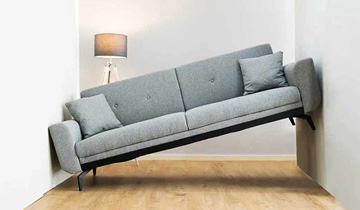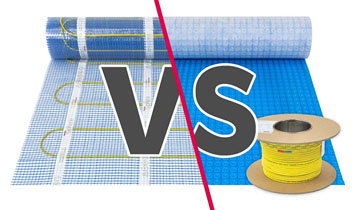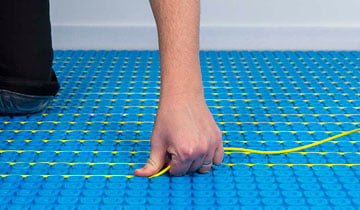7 min read
How much does electric underfloor heating cost in 2022?
Well, that’s a good question I must admit! The short answer is ‘not much’ but that doesn’t really cut the mustard for most people, so I have done my...
4 min read
 Rhylan Bell
:
Feb 22, 2022
Rhylan Bell
:
Feb 22, 2022

Probably if you’ve ended up at this blog, you’ve already decided to use electric underfloor heating in your project.
However, this blog isn’t for you if you’re still deciding how to heat your house, but we’ve got stacks of other information on the different way you can heat your home, complete with all the pros and cons, over at our insight page. Head over there and you might even end up back here again later…!
From this blog, you get a great understanding of how to work out exactly how much electric underfloor heating you need for your project, as well as some ball-park figures to help you budget for how much it will cost to purchase.
I like to think of electric underfloor heating as a three-part system:
In its simplest form, you need one thermostat per zone (room or space that you are heating). Some people often ask me if they can combine zones together to save on the purchase cost, and the short answer is yes.
However…
If you combine zones together, they will operate at the same temperature and at the same time. So, if you’ve got a kitchen & dining room on one zone, this can cause issues – the kitchen has loads of other appliances that kick out heat, whereas the dining room won’t. This means that the two rooms have completely different heating requirements, so the optimum efficiency and comfort will be difficult to achieve.
So, where possible, the more zones, the more efficient and comfortable your electric underfloor heating will be.
Also, each thermostat can control up to 16 amps (A) or 3,600 watts (W). At 150W/m2 this is approximately 24m2. If the area is larger than this, fret not, we can simply add a ‘contactor snubber’ which allows the thermostat to switch a larger area.
This one is simpler. Once you have chosen the type of insulation board you need, then you need to work out the total area of your room. The general rule of thumb is to choose coated insulation board for timber substrates and uncoated insulation board for concrete substrates.
To do this, multiply the width of the room by the length of the room to give a square metre area. We recommend adding 10% to this figure to allow for any wastage when installing the insulation as it comes in boards. This will give you the total amount you need, which will be able to be quoted by your chosen supplier.
How much electric underfloor heating do I need?
Right, this is the crunch point… so some context first.
Each individual heating mat/cable that has its own unique fixed resistance per linear metre. This means that the cable cannot be altered in length at all without affecting the heat output of the system.
So, you’ve probably figured out that this means that you need to always make sure you haven’t got too much heating cable. Correct! It’s really important that you under-quote, rather than over-quote.
However, there is a bit more to this as well.
With underfloor heating, it’s also important to work out something we call the ‘available heating space’. This is the total area of the floor, minus any floor area that is taken up by fixtures like baths, vanity units, wardrobes etc.
You can imagine what happens if this step isn’t thoroughly done… here’s an example:
The customer has a bathroom project with an area of 5m2. The supplier provides a 5m2 mat.
Hang on. There’s a bath. Inevitably the question asked is ‘can I cut the cable?’
NO…. please don’t!
So, the way we fix this is by getting the system right in the first place.
The same 5m2 bathroom may only have 4.3m2 of heating space. So, we will quote enough to cover this ‘available heating space’, then round down to the nearest size – which for the mesh system would be 4m2. Problem averted.
But hold on… I hear you say… is that still enough to heat my room?
Yes, as long as you cover 85% of the available floor area of a bathroom, this will still be enough to act as a primary heat source.
So, to summarise, for your underfloor heating you will need:
Don’t forget to check out ‘What you need to know before installing electric underfloor heating’ for further detail and some great calculations to use.
Well, a lot of underfloor heating suppliers’ costs do vary, so I’ll try and give you a rough idea for your budgeting purposes.
With a RRP price of £52/m2, ThermoSphere Mesh is the most common type of underfloor heating for tile and stone floors in the UK. So, if your bathroom is 4m2, and you are finishing it with tiles, the RRP for the Mesh electric underfloor heating will be about £260. The ThermoSphere Foil system for wood, carpet and vinyl floors will be about the same amount as Mesh. There is also a specialist system for tile and stone floors that includes a decoupling membrane which has a RRP of £73.50/m2.
The RRP for insulation board can vary between £12/m2 and £30/m2, which is dictated by the type of insulation board you need.
Thermostats can vary between £90 for a manual thermostat to £219 for a smart thermostat.
Of course, all of these prices are based on RRP, and installers can typically get a 20-30% discount off this from one of the many resellers. Don’t forget that you can check out your local ThermoSphere retailer via the ‘Where to buy’ page.
The average quote to install 10m2 of electric underfloor heating is £800. However, the cost can vary depending on what type of project it is being installed for. For new build projects you would be looking at £50 – £75 per metre squared and for renovations, the cost will be between £60 and £85 per metre squared.
Thank you to Checkatrade for this data!
So, there we have it… that’s a lot of words for basically saying:
Hopefully that has all been helpful. Ultimately every project is different, so if you want to discuss your specific requirements, then the team here to help.
Thanks for sticking with me to the end, I trust it has been helpful, and all the very best with your project!

7 min read
Well, that’s a good question I must admit! The short answer is ‘not much’ but that doesn’t really cut the mustard for most people, so I have done my...

14 min read
Deciding what is the best electric heating system to use for your project can often be confusing especially when many of them can effectively heat...

8 min read
If you are in the market for an electric underfloor heating system for your next home renovation, then you have landed in the perfect place. We’ve...